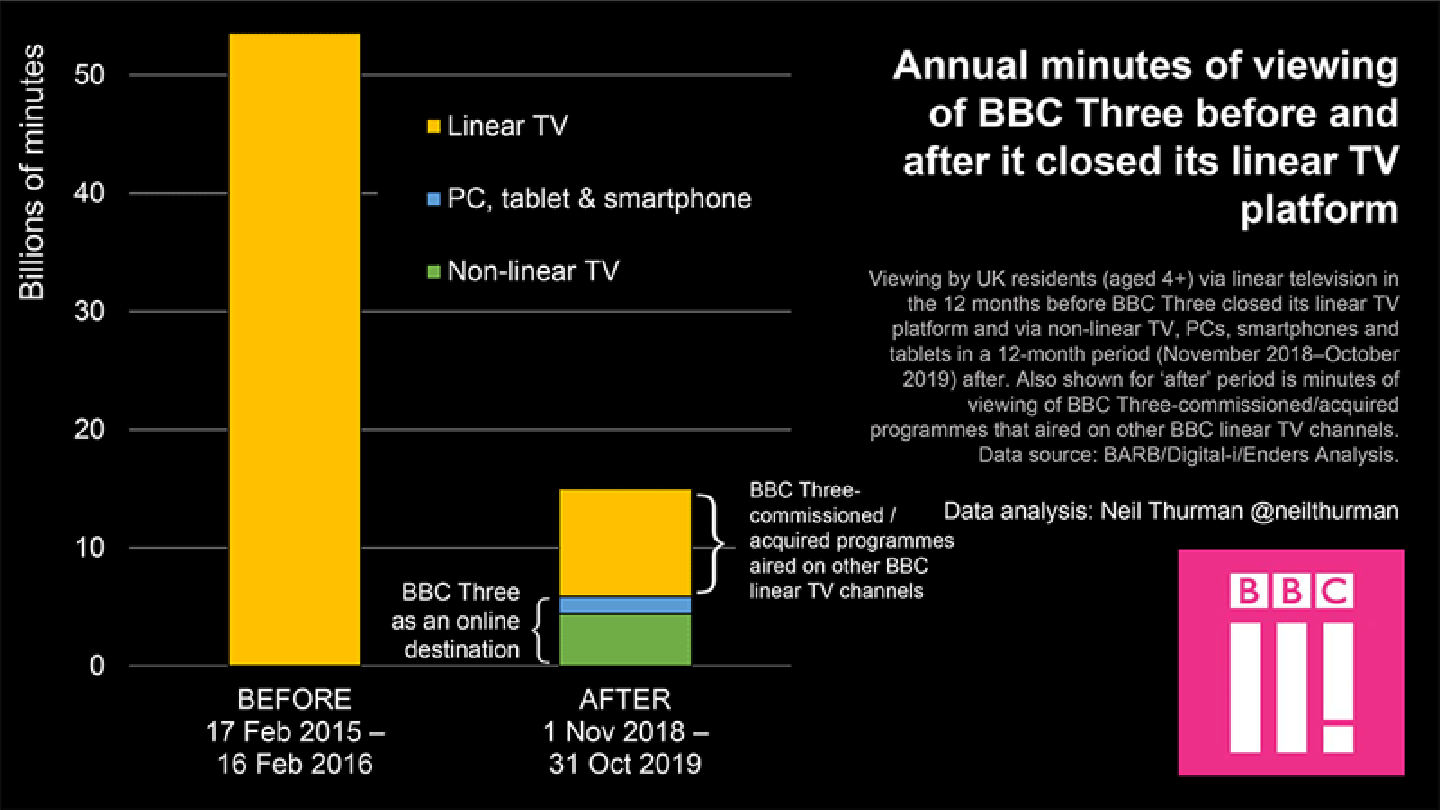New, first-of-its-kind research from City, University of London reveals BBC Three was viewed for 89 per cent fewer minutes per year after it closed its broadcast platform than it was on linear television before.
Published (Updated )
Even including the viewing of BBC Three programmes, such as Killing Eve and Fleabag, on the BBC’s other linear television channels, viewing minutes still fell by 72 per cent.
The study also estimates BBC Three’s audience shrank by 60–70 per cent after its broadcast platform was closed – a much steeper decline than that of the channel’s competitors, who continued to broadcast.
The author, Dr Neil Thurman, Honorary Senior Research Fellow in the Department of Journalism at City, University of London, suggests that the BBC is right to be considering bringing the channel back to linear television if they want to attract more attention from BBC Three’s 16–34-year-old target audience.

In February 2016, BBC Three became the first-ever television channel to cease linear broadcasting and instead prioritise offering its programming on-demand, via the internet. The change generated savings of around £50 million per year, which helped fill a funding gap caused by the freezing of the BBC licence fee in 2010.
Dr Thurman used data from The Institute of Practitioners in Advertising’s (IPA) annual TouchPoints Hub Survey and the Broadcasters’ Audience Research Board (BARB) to analyse the effects of BBC Three’s online reinvention with respect to audience size, viewing intensity and programme genre availability and consumption.
“Time spent with BBC Three fell just as sharply as it has at other media brands, like The Independent and the New Musical Express (NME)”, says Dr Thurman, suggesting that the negative effects on time spent caused by closing their offline platforms are similar for TV stations and print publications.

Not only has the time spent with the channel been hugely reduced, but most (79%) of the online viewing is still via television sets. Dr Thurman believes this shows that “televisions remain the preferred device for watching televisual content, even at a channel that has reinvented itself online”.
“The size of BBC Three’s weekly and monthly audience, in common with most of its competitor TV channels, was declining before it reinvented itself online. However, its decision to stop broadcasting resulted in sharp drops,” says Dr Thurman.
Comparing the year before its online reinvention against the year after shows its 16–34-year-old target audience shrank 69 per cent on a weekly basis and 60 per cent on a monthly basis.
These falls were about three and five times higher than the falls that took place over a comparative period – 2013 to 2015 – when BBC Three was still broadcasting on television.
BBC Three’s falls in audience size contrast with its broadcast competitors. Their audiences have declined, but to a lesser degree. Dr Thurman estimates that the closure of BBC Three’s linear TV platform caused at least three-quarters of the drop in its audience size.
When it reinvented itself online, the channel’s content was refocused around two editorial pillars: ‘Make Me Think’ (drama, documentary, news and current affairs) and ‘Make Me Laugh.’
The study found that BBC Three did increase the proportion of drama and factual in its output. However the proportion of its output devoted to comedy actually fell post-broadcast, likely because it dropped US animation imports like Family Guy and American Dad!

Although comedy makes up a lower proportion of the minutes of programming available on BBC Three since it closed its broadcast platform, the genre accounts for a higher proportion of viewing minutes since the closure.
“Viewers are freer to choose what to watch now, unrestricted by the linear schedule. My study indicates they might be using this freedom to watch a different mix of programmes than they did before”, says Dr Thurman.
BBC Three is no longer the only TV channel to have reinvented itself online. In January 2020, the Danish Broadcasting Corporation closed the broadcast platforms of two of its youth channels, DR Ultra and DR 3.
Dr Thurman said: “It’s too early to say whether their experiences will mirror BBC Three’s, but I expect they will.”
“Surprisingly the data shows that the size of BBC Three’s 16–34-year-old target audience shrank more than the size of its 35+ audience.
“This raises doubts about whether, in the context of youth channels like BBC Three, young audiences are, as the BBC’s director general Tony Hall suggested, ‘most ready to move to an online world.’"
Read the full paper, When a TV channel reinvents itself online: Post-broadcast consumption and content change at BBC Three, by Dr Neil Thurman.
The full report was published by Enders Analysis.
